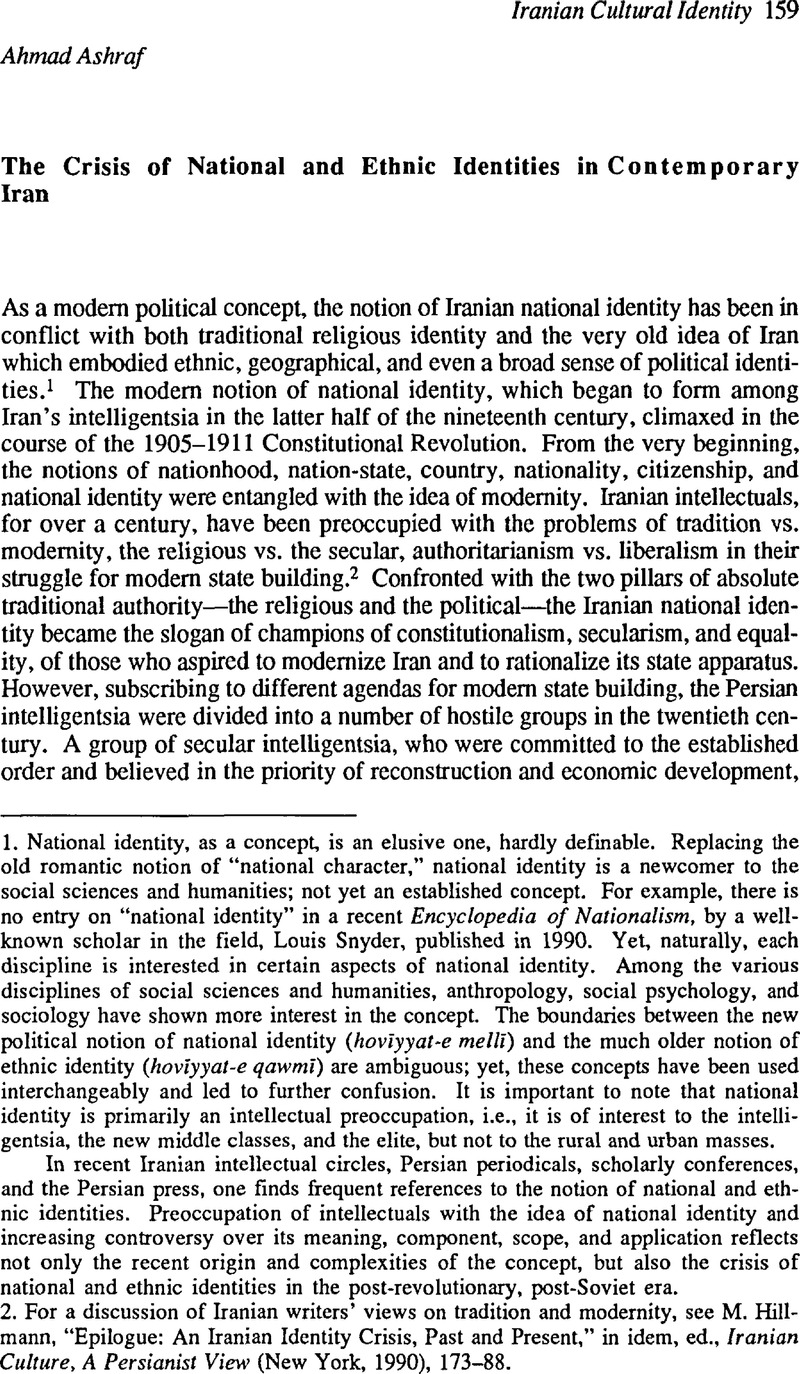Article contents
The Crisis of National and Ethnic Identities in Contemporary Iran
Published online by Cambridge University Press: 01 January 2022
Abstract

- Type
- Symposium: Iranian Cultural Identity
- Information
- Copyright
- Copyright © Association For Iranian Studies, Inc 1993
References
1. National identity, as a concept, is an elusive one, hardly definable. Replacing the old romantic notion of “national character,” national identity is a newcomer to the social sciences and humanities; not yet an established concept. For example, there is no entry on “national identity” in a recent Encyclopedia of Nationalism, by a wellknown scholar in the field, Louis Snyder, published in 1990. Yet, naturally, each discipline is interested in certain aspects of national identity. Among the various disciplines of social sciences and humanities, anthropology, social psychology, and sociology have shown more interest in the concept. The boundaries between the new political notion of national identity (hovīyyat-e mellī) and the much older notion of ethnic identity (hovīyyat-e qawmī) are ambiguous; yet, these concepts have been used interchangeably and led to further confusion. It is important to note that national identity is primarily an intellectual preoccupation, i.e., it is of interest to the intelligentsia, the new middle classes, and the elite, but not to the rural and urban masses.
In recent Iranian intellectual circles, Persian periodicals, scholarly conferences, and the Persian press, one finds frequent references to the notion of national and ethnic identities. Preoccupation of intellectuals with the idea of national identity and increasing controversy over its meaning, component, scope, and application reflects not only the recent origin and complexities of the concept, but also the crisis of national and ethnic identities in the post-revolutionary, post-Soviet era.
2. For a discussion of Iranian writers' views on tradition and modernity, see Hillmann, M., “Epilogue: An Iranian Identity Crisis, Past and Present,” in idem, ed., Iranian Culture, A Persianist View (New York, 1990), 173–88Google Scholar.
3. For a summary of this view see Irānshenāsī 4, no. 2 (Summer 1992): 234–5.
4. See, for example, Gnoli, G., The Idea of Iran: An Essay on its Origin (Rome, 1989Google Scholar); see also Yarshater, E., “Cherā dar Shāhnāmeh az pādeshāhān-e Mād va Hakhāmaneshā ẕekrī nīst?” in Iran-Nameh 3, no. 2 (Winter 1984): 191–213Google Scholar.
5. See, for example, Jalal, Matini and Jalal, Khaleghi-Motlagh, “Irān dar goẕasht-e rūzgārān,” in Iranshenāsī 4, no. 2 (Summer 1992): 233–68Google Scholar.
6. For a democratic leftist view see, for example, Hekmat, B., “Forūpāshī-ye dawlat va takassor-e qodrat,” in Irān dar āstāne-ye sāl-e 2000 (Paris, 1992), 107–127Google Scholar; Babak, Amir Khosrovi, “Moshārekat dar baḥ![]() -e mas'ala-ye mellī va barrasī-ye ejmālī-ye ān dar Irān,” a series of articles in Rāh-e āẕadī (1991–92)Google Scholar, various issues. For a liberal nationalist view see Pishdad, A. and Katouzian, M. A. H., Mellī klst va nahżat-e mellī chīst? (London, 1990Google Scholar); and idem, Nahżat-e mellī-ye Irān va doshmanān-e ān (London, 1991)Google Scholar. For the view that the formation of civil society is a prerequisite of a modern national identity, see A. A. Hajj Sayyed Javadi's response to and interview, “Kīstīm va az kojā'īm?” in Mohājer 8, nos. 71–72 (1992).
-e mas'ala-ye mellī va barrasī-ye ejmālī-ye ān dar Irān,” a series of articles in Rāh-e āẕadī (1991–92)Google Scholar, various issues. For a liberal nationalist view see Pishdad, A. and Katouzian, M. A. H., Mellī klst va nahżat-e mellī chīst? (London, 1990Google Scholar); and idem, Nahżat-e mellī-ye Irān va doshmanān-e ān (London, 1991)Google Scholar. For the view that the formation of civil society is a prerequisite of a modern national identity, see A. A. Hajj Sayyed Javadi's response to and interview, “Kīstīm va az kojā'īm?” in Mohājer 8, nos. 71–72 (1992).
7. See ‘A. Shari'ati, Bāzshenāsī-ye hovīyyat-e Irānī-Eslāmī (Tehran, 1982); see also M. Bazargan, “Nahżat-e żedd-e Irānī,” in Kayhān, 14 September 1980.
8. See, for example, Sadiq, J., Mellīyat va enqelāb dar Irān (New York, 1973)Google Scholar.
9. For a thoughtful review of the leftist views of national identity and the question of nationalities see Babak Amir Khosrovi, op. cit.. For an orthodox Marxist-Leninist- Maoist view and its application to the question of nationalities in Iran, see “Mas'alaye mellī dar Irān,” in Hemmat, no. 11 (1977): 1–125.
10. For views of 43 Iranian Intellectuals on Iranian national identity, see Javadi, “Kīstīm,” 17–35. See also Shahrokh Meskoob, Iranian Nationality and the Persian Language, trans. M. C. Hillmann (Washington: Mage Publishers, 1992). Race is rarely taken up as the main element of identity by Iranian intellectuals. However, a modified version of racial identity, in combination with territorial and cultural ones, is constructed by the celebrated poet and literary critic, Nader Naderpour. He believes that blood ties (Indo-European origin, Aryan race, and Iranian stock), territorial ties (Iranian history, the Iranian plateau, and the Iranian state), and cultural ties (the Persian language, Persian arts, and Persian customs) are the pillars of the “glorious palace of Iranian nationality.” He emphatically rejects Shi'ism as playing any role in the Iranian identity formation. See Naderpour, N., “Hovīyyat-e mellī va zabān-e moshtarak” in Ketāb-e Nīmā, no. 3 (1990): 19–37Google Scholar.
11. See, for example, the views of M. Ajoudani, B. Amir Khosrovi, N. Pakdaman, J. Khaleghi-Motlagh, A. Karimi-Hakkak, Homa Nateq, and N. Mirzadeh (Azarm) in “Kīstīm,” 17–35. For the opinions of those who do not see the Persian language as the dominant criterion of Iranian national identity and prefer to underline common history and common customs as the foundation of Iranian identity, see the views of M. Qasemi, M. J. Mahjoub, and J. Matini, in Mohājer 8, nos. 71–72 (1992): 26–8. For other views concerning the significance of the Persian language in the formation of Iranian identity, see five articles by N. Darya-Bandari, N. Naderpour, M. A. Sepanlu, A. Karimi-Hakkak, and D. Ashuri, in a special issue on “Zabān va hovīyyat-e mellī” of Ketāb-e Nīmā, no. 3 (1990): 5–72.
12. See further A. Ashraf, “ Hovīyyat-e Irānī,” in Irān dar āstāne-ye sāl-e 2000, 143–66.
- 14
- Cited by




